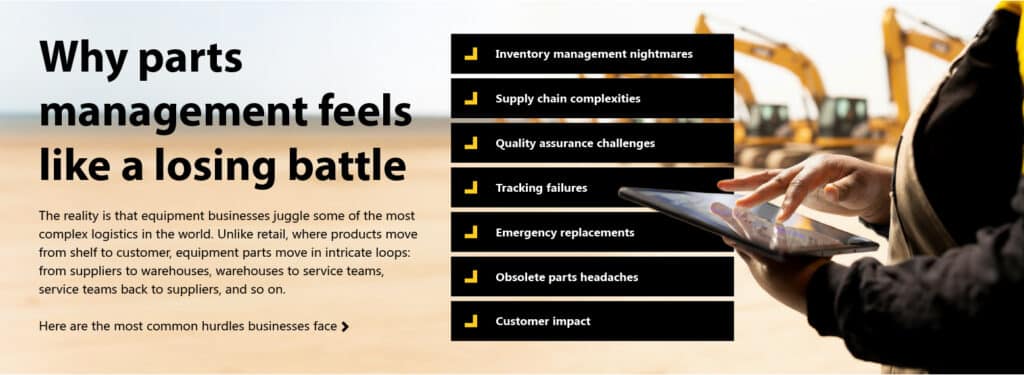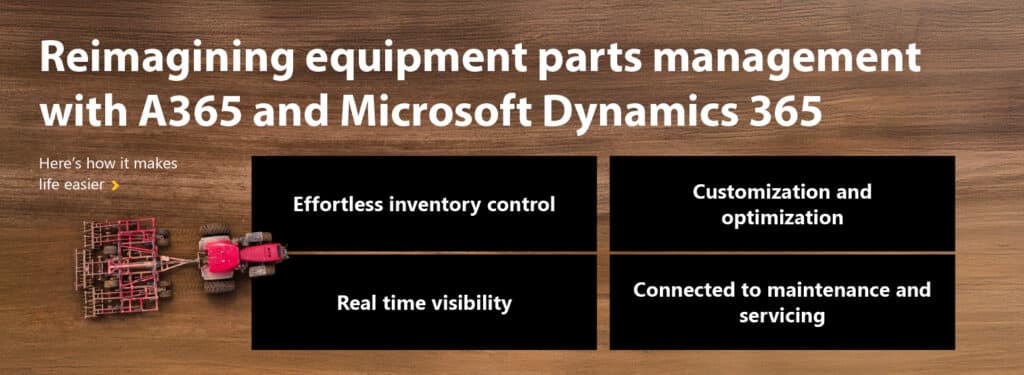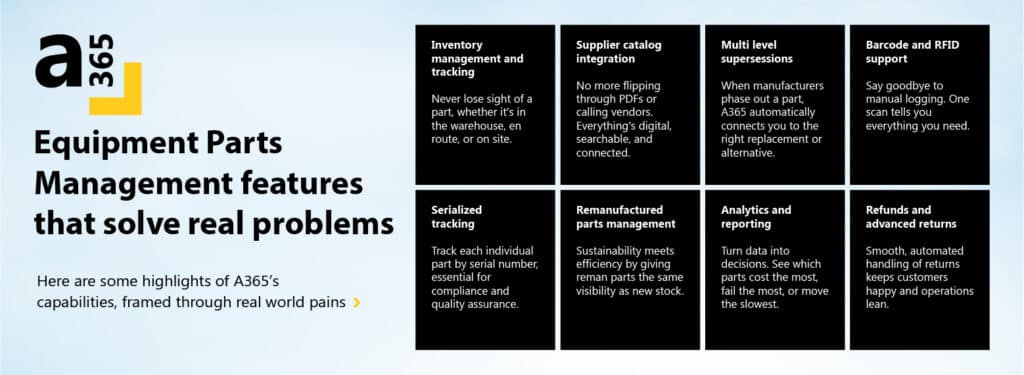If you’ve ever been in the middle of a critical repair, only to discover that the part you desperately need is either missing, mislabeled, or stuck somewhere in the supply chain, you know the frustration of bad equipment parts management. Equipment businesses live and breathe uptime. When a piece of machinery goes down, every minute counts. Yet, for too many organizations, parts handling is still clunky, manual, and reactive.
It doesn’t have to be this way.
Enter A365, built on Microsoft technologies, a next-generation solution that transforms the way equipment businesses manage, track, and optimize parts across their entire operation. Before we dive into how it does that, let’s first look at why equipment parts management has become one of the most overlooked yet mission-critical pain points in the industry.
Why equipment parts management feels like a losing battle

Here are the most common hurdles businesses face:
- Inventory management nightmares: Overstocking ties up capital, understocking delays service. Many businesses don’t even know what they actually have until a crisis strikes.
- Supply chain complexities: Multiple vendors, inconsistent lead times, and sudden disruptions make procurement unpredictable.
- Quality assurance challenges: Sending a faulty part to a customer doesn’t just cost money, it costs trust.
- Tracking failures: Without real-time visibility, parts vanish into a black hole of manual records and outdated spreadsheets.
- Emergency replacements: When equipment is down, there’s no time to dig through catalogs or guess at availability. Speed is everything.
- Obsolete parts headaches: Holding onto parts that no longer fit current equipment models eats up space and resources.
- Customer impact: At the end of the day, customers don’t care about your parts problems. They just want equipment that works, now.
Most businesses end up patching together manual processes or investing in point solutions that fix one issue but ignore the bigger picture. That’s like putting a band aid on a cracked pipeline.
Reimagining equipment parts management with A365 and Microsoft Dynamics 365
This is where A365 comes in. Built on the reliability and power of Microsoft technologies, A365 takes the chaos of equipment parts management and turns it into a streamlined, intelligent workflow.
Instead of juggling multiple systems, A365 consolidates everything: ordering, tracking, supplier management, analytics, compliance, and customer communication. Think of it as moving from a messy backroom full of unmarked boxes to a digitally connected ecosystem where every part has a place, every transaction is visible, and every action is proactive rather than reactive.

Here’s how it makes life easier:
- Effortless inventory control: Set reorder points, track parts across multiple locations, and automate replenishment.
- Customization and optimization: Tailor the system to your unique workflows while tapping into standardized industry best practices.
- Real-time visibility: No more guessing games, see exactly what’s available, where it is, and when it’s needed.
- Connected to maintenance and servicing: Directly tie parts availability to service schedules, so technicians never show up empty-handed.
In short: A365 doesn’t just manage parts, it manages the entire parts lifecycle.
Features that solve real problems
While features alone don’t make a great system, what matters is how they solve the real frustrations equipment businesses face.

Every feature is designed not just to add functionality, but to remove friction.
Why A365 wins: The Microsoft advantage
There are plenty of systems that claim to streamline parts management, so why choose A365? The answer lies in its foundation.
Because A365 is built on Microsoft technologies, it doesn’t exist in a silo. It integrates seamlessly with tools you already use: Microsoft Dynamics 365, Power BI, Azure, creating a single ecosystem rather than another standalone app.

In other words, A365 combines the specialized functionality of an industry-specific solution with the robustness of a global technology platform.
The human side: customer and supplier relationships
One of the overlooked benefits of modern equipment parts management is how it improves relationships. When your system is reactive, suppliers get frustrated with unclear orders, and customers get angry at delays.
With A365:
- Suppliers see clear, consistent, digital orders.
- Customers get faster service and accurate updates.
- Internal teams spend less time firefighting and more time creating value.
In an industry where trust is currency, A365 becomes a competitive advantage.
The bottom line: from cost center to value driver
Traditionally, parts management has been seen as a necessary evil, a back-office function that eats resources but doesn’t add value. A365 flips that narrative.
By reducing waste, cutting downtime, and improving decision-making, equipment parts management becomes a profit driver. Equipment businesses can finally move from inefficient, reactive handling to streamlined, intelligent workflows that enhance every aspect of the business.
Final thoughts
Equipment parts management isn’t glamorous. It’s not the shiny new machine on the factory floor or the cutting-edge piece of equipment in the field. But it’s the backbone of the entire operation. Without the right part, at the right time, in the right place, nothing works.
That’s why A365 matters.
Built on Microsoft technologies, A365 doesn’t just give you better tools. It gives you control, confidence, and clarity in one of the most critical yet chaotic parts of your business.
The future of equipment businesses isn’t just about the machines they run, it’s about the intelligence behind every part that keeps them running. And with A365, that future is here.
To delve deeper into effective equipment parts management for your equipment business, visit our website or engage in a chat with our consultants today to transform your challenges into opportunities.













